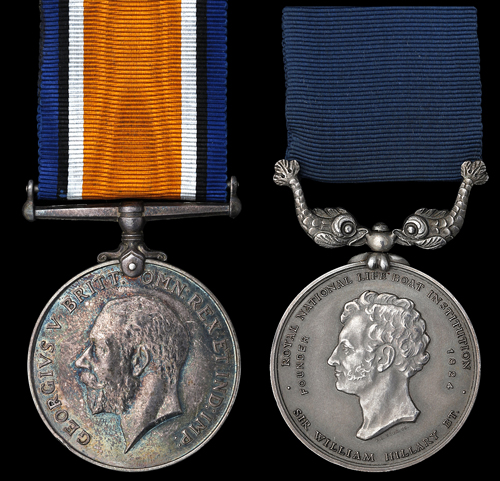
Auction: 11010 - Orders, Decorations, Campaign Medals & Militaria
Lot: 298
A Superb R.N.L.I. Silver Medal Pair to Motor Mechanic H.W. Jefferson, Hartlepool Lifeboat, For the Gallant Rescue of the Crew of the S.S. Hawkwood, 26.1.1942, When, Under the Command of Lieutenant Bennison, He Thrice Went to the Rescue of the Stricken Crew; For This Action the Coxswain Was Awarded The R.N.L.I. Gold Medal; Previously Honoured For His Gallantry, Jefferson was Instrumental in Rescuing 47 Lives During the Second World War British War Medal (H.W. Jefferson.); Royal National Lifeboat Institution Medal, silver, type 5 1937-to date, obverse: head of Sir William Hillary, Bt., the founder, facing left (Herbert W. Jefferson, Voted 12th. March 1942.), engraved in upright serif capitals, with uniface ´dolphin´ suspension, in R.N.L.I. leather case of issue, good very fine, together with a large quantity of research and four photographic images of the recipient (2) Estimate £ 1,400-1,800 Herbert William Jefferson, Motor-Mechanic, Hartlepool Lifeboat, citation reads: ´26th January 1942: With an easterly gale blowing and fierce snow squalls, the London S.S. Hawkwood went ashore in a rough sea, half a mile north of the Tees North Gare Jetty at Hartlepool, Co. Durham. The Watson class motor launch The Princess Royal launched at 7:35am and, on arrival, found the wreck in two parts lying in water too shallow for approach; therefore Coxswain Bennison returned to station. He went out again in the afternoon and, with heavy seas breaking into the lifeboat, took off five men from the fore part of the wreck and landed them. A third trip to rescue men on the aft part was unsuccessful. The remaining survivors were later saved by rocket apparatus.´ The Steam Ship Hawkwood, 2,024 tons, was launched in October 1934 from the Austin yard in Sunderland, and at the time of her wreck was carrying coal from Blyth to London. She broke in two and the parts were later reported as being 500 feet apart. The fore end was subsequently salvaged and sent for scrapping. For this action Lieutenant William Henry Bennison, C.G.M., R.N.V.R., Coxswain, Hartlepool Lifeboat was awarded the R.N.L.I. gold medal; Herbert William Jefferson was awarded the R.N.L.I. silver medal; and the six crew members of The Princess Royal were awarded the R.N.L.I. bronze medal. All received gratuities of £4 8s 6d. Wreck of the Hawkwood ´At 6:55am in the morning word came from the coastguard that he had seen rockets from a vessel off Seaton Carew. The life-boat was called out at once, but there was a slight delay, as the ferry boat in which the crew had to cross the harbour to the life-boat station was packed with workmen. The motor life-boat The Princess Royal (Civil Service No.7) got away at 7:35am. An easterly gale was blowing, with fierce squalls of snow. A very rough sea was running, breaking far from the shore, and it was still very dark. Although the vessel in distress was only three miles south of Hartlepool in a direct line, the life-boat had a longer journey, as she had to go seaward in order to keep clear of various unlighted buoys, wrecks, and coast defences. Then, when she was off the entrance to the Tees, she stood inshore and, at 8:30am, as day was breaking, she found the wreck half a mile north of the Tees North Gare Jetty, the S.S. Hawkwood, of London, with a crew of 23 on board. She had broken in two immediately abaft her bridge. The stern part, on which several men could be seen, was right in shore in very shallow water off the sandy beach. The fore part, on which men could also be seen, was 200 yards further out, but it too was in very shallow water. After studying the wreck for some time the coxswain decided that both ends were in water too shallow for the life-boat to get to them, and, as the crew were not in immediate danger, he decided to return to Hartlepool, and to attempt a rescue at high water. He arrived at Hartlepool at 9:50am. The life-boat set out a second time at 11:35am and reached the wreck at 12:15pm. The gale was still blowing as strongly, with fierce squalls of snow and a very rough sea. Where the stern of the steamer lay the water was still too shallow for the life-boat to get near, but the coxswain made for the fore part. It was being swept by heavy seas, and the five men on board it were now so exhausted that they could not have held on for much longer. The coxswain handled the life-boat very skilfully, brought her alongside and, with the engines working, held her there while the five men, watching their opportunity, jumped aboard. Heavy seas were continually breaking in the life-boat, and they were so violent that at times she was almost standing on end. The coxswain could see that the coastguard life-saving apparatus was now attempting to fire a line from the shore to the stern part of the steamer, and returned to Hartlepool, sending a request by wireless to the naval base for an ambulance to meet the life-boat. It was there when the life-boat reached Hartlepool at 1:30pm, and the five men were at once taken to hospital. The gale now appeared to moderate, and the life-boat put out to sea for the third time at 2:35pm to attempt the rescue of the men on the stern part. She reached it at 3:15pm, but the heavy breaking seas and the shallow water still prevented her from going close. The coxswain used oil, but it would not flatten the seas. He then anchored and dropped down on the cable towards the wreck, hoping to come near enough to fire a line from the line throwing gun and rescue the men by means of the breeches buoy, but the life-boat still could not get close enough. Though she was still out of range of the wreck she touched the sandy bottom, and a sea breaking over her stern flooded the after cockpit, stunned the motor-mechanic, and slightly injured another member of the crew. The coxswain could see that the men on the wreck were sheltering behind the deck house and were comparatively safe for the present, so he decided to return to harbour and make another attempt at high water that night. The life-boat reached Hartlepool at 5:20pm. She did not have to put out for a fourth time, for at low water that evening the coastguard reported that they had at last managed to get a rocket to the wreck, and a second message said that all the men on board had been rescued. Throughout the three attempts the coxswain had handled the life-boat with great judgement, and in the actual rescue of five men had shown courage, skill, and determination. Throughout a long and arduous day, and extremely bad weather, he had been ably supported by the crew, and particularly the motor-mechanic.´ (R.N.L.I. official account refers). The master of the Hawkwood, in a letter of thanks to the honorary secretary of the station, said: ´We would like you to know that we will always remember the fearless and persistent determination displayed by the crew of the life-boat under the gallant command of the coxswain, Lieutenant W.H. Bennison, C.G.M., R.N.V.R., who showed such indomitable courage, initiative, and superb seamanship. We all deeply appreciate that we owe our lives to these men, who would have been fully justified (and felt that they had done their duty) after their first attempt to approach the wreck, to have made no further effort. But it was apparent that these men were wholly fearless and inspired by the spirit of self-sacrifice and determination not to be beaten by the tremendous odds against them.´ Motor Mechanic Herbert William Jefferson was born in Hartlepool in 1883 and after serving in the fishing fleet for fourteen years entered the lifeboat service in 1915. He took part in the attempted rescue of the people on the Hospital Ship Rohilla off Whitby in October 1914 whilst serving in the trawler Mayfly, which towed the Whitby lifeboat to the wreck. It was for his services with the lifeboat that he received the British War Medal. He became Motor Mechanic of the Hartlepool lifeboat in 1923. A Gallant Mechanic On the 21st October, 1927, Jefferson was at work in the boat-house cleaning the engine, when the engine backfired and set alight the cleaning rags which were saturated with oil and paraffin. There were some eighty gallons of petrol in the tanks just on the other side of the bulkhead, and had they exploded, he would have been wrapped in flames, and the boat and boat-house destroyed. He got to work at once with the fire-extinguishers, whilst his little boy, who was with him, ran for help. The flames, however, were so great that the extinguishers made little impression on them; so he threw once of the extinguishers into the engine-room and closed the hatchers. The winchman, Mr. Bunton, had now arrived in answer to young Jefferson´s call, and very quickly released the boat down the slipway. Jefferson, who remained on board, took the helm and the boat ran out into the harbour. This prompt action would have saved the boat-house, even if the boat herself had gone up in flames, but fortunately, with the hatches closed, the fire quickly burnt itself out, with minimal damage to the boat. For the great courage he had shown in taking such prompt and successful steps to put out the fire at considerable risk to himself, he was awarded the Thanks of the Institution and a gratuity of £50. Mr. Bunton was awarded £5, and Jefferson´s son an inscribed copy of Britain´s Lifeboats. During the Second World War Jefferson was called out twenty times and was instrumental in saving 47 lives. Awarded the R.N.L.I. silver medal in 1942 for gallantry in the rescue of the crew of the S.S. Hawkwood, he was modest about his part: ´All want to do is to pay my tribute to the coxswain. But for his coolness and resource we would not have accomplished what we did´ (Northern Daily Mail, 19.1.1943 refers). He died on the 19th January 1943. Provenance: Buckland, Dix, and Wood, June 1991.
Sold for
£3,200




